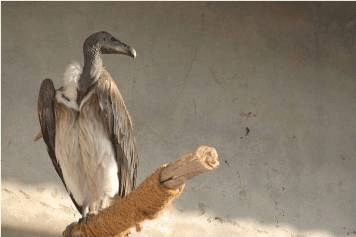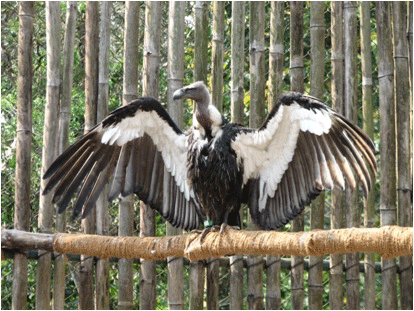A Decade Of Vulture Conservation In India
By Marianne de Nazareth
25 January, 2014
Countercurrents.org
 After the success of its Vulture Conservation Breeding Programme in Haryana, West Bengal and Assam, BNHS-India (Bombay Natural History Society) is all set to set up a Vulture Safe Zone in Madhya Pradesh. In continuation of its decade-old vulture conservation programme, BNHS-India, in association with Rio Tinto and BirdLife International, is all set to establish a Vulture Safe Zone (VSZ) in the Bundelkhand region of Madhya Pradesh. The Memorandum of Understanding (MoU) for this joint project was signed in January 2014, in the presence of BNHS and Rio Tinto officials at Hornbill House in Mumbai.
After the success of its Vulture Conservation Breeding Programme in Haryana, West Bengal and Assam, BNHS-India (Bombay Natural History Society) is all set to set up a Vulture Safe Zone in Madhya Pradesh. In continuation of its decade-old vulture conservation programme, BNHS-India, in association with Rio Tinto and BirdLife International, is all set to establish a Vulture Safe Zone (VSZ) in the Bundelkhand region of Madhya Pradesh. The Memorandum of Understanding (MoU) for this joint project was signed in January 2014, in the presence of BNHS and Rio Tinto officials at Hornbill House in Mumbai.
The Vulture Action Plan 2006 of Ministry of Environment & Forest, Government of India and South Asian Vulture Recovery Plan 2004, after observing the drastic fall in vulture numbers and based on advocacy by organizations such as BNHS, recommended a complete ban on veterinary use of diclofenac. Identification of vulture safe drugs and establishment of Vulture Conservation Breeding Programme to save vultures from imminent extinction were the other focus areas. Years down the line, despite good success in captive breeding of vultures at centres run by BNHS and RSPB and identification of safe drugs such as Meloxicam, the wild population continues to be under constant threat of Diclofenac poisoning, since human Diclofenac is still illegally used for veterinary purposes. Even if a vulture feeds just once on a diclofenac laced carcass, it dies. It is therefore important that concerted efforts are made in the areas where there are extant populations of vultures to save these very useful birds from extinction. The concept of VSZ will play a vital role in the long-term survival of vultures in South Asia.
According to the paper published by the Ministry of Environment and Forests, Government of India, in 2006 an action plan for vulture conservation was planned for India. Looking at the background of the whole issue is important if we are unaware of it. India has nine species of vultures in the wild.
These are the Oriental White-backed Vulture (Gyps bengalensis), Slender billed Vulture (Gyps tenuirostris), Long billed Vulture (Gyps indicus), Egyptian Vulture (Neophron percnopterus), Red Headed Vulture (Sarcogyps calvus), Indian Griffon Vulture (Gyps fulvus), Himalayan Griffon (Gyps himalayensis), Cinereous Vulture (Aegypius monachus) and Bearded Vulture or Lammergeier (Gypaetus barbatus). The population of three species i.e. White-backed Vulture, Slender billed Vulture and Long billed Vulture in the wild has declined drastically over the past decade. The decline of Gyps genus in India has been put at 97% by 2005. Because of the evidence of widespread and rapid population decline, all three vulture species were listed by IUCN, the World Conservation Union, in 2000 as ‘Critically Endangered’, which is the highest category of endangerment.
So what is the significance for human well-being when it comes to Vultures?
 The ecological, social and cultural significance of vultures in India may be summed up as: scavenging on animal carcasses of animals and thereby helping keep the environment clean; and the disposal of dead bodies as per the religious practices of the Parsi community. Vultures are the primary removers of carrion in India and Africa. Removal of a populations of other scavenging species and/or result in increase in putrefying carcasses. In the absence of carcass disposing mechanisms, vulture declines country side. In some areas the population of feral dogs, being the main scavenging species in the absence of vultures, has been observed to have exploded which is not safe for humans.
The ecological, social and cultural significance of vultures in India may be summed up as: scavenging on animal carcasses of animals and thereby helping keep the environment clean; and the disposal of dead bodies as per the religious practices of the Parsi community. Vultures are the primary removers of carrion in India and Africa. Removal of a populations of other scavenging species and/or result in increase in putrefying carcasses. In the absence of carcass disposing mechanisms, vulture declines country side. In some areas the population of feral dogs, being the main scavenging species in the absence of vultures, has been observed to have exploded which is not safe for humans.
Looking at the status of population of Gyps Vultures in the Indian Subcontinent, surveys on the population status of vultures have been carried out and reasons for their sudden decline studied by various avian experts. Decline of vulture populations in India was first recorded at the Keoladeo Ghana National Park, Rajasthan during mid 1980’s to mid 1990’s, followed by Northern India road counts. Declines have been projected in excess of 97% over a 12 year period in India.
The Asian vulture population crash was first revealed in 1999 with investigations on the cause of decline beginning in 2000. In India, the initial hypotheses for the drastic decline in population were non-availability of food (dead livestock) as they were perhaps being removed for commercial purposes, or an unknown viral epidemic disease. A hypothesis of epidemic disease were carried out by the BNHS, IVRI and others on the birds. Visceral gout, an accumulation of uric acid within tissues and on the surfaces of internal organs, was observed in 85% of dead vultures found. Death was caused by renal failure, which is known to occur as a result of metabolic, infectious or toxic disease. Visceral gout was observed in approximately 85% of dead adult birds. Populations of three of India’s commonest Griffon vultures have declined by more than ninety per cent during the last decade and since late 1999 ZSL has been working closely with the Bombay Natural History Society (BNHS) and the RSPB to investigate this problem.
Two of the three affected species, the Oriental white-backed and the Long-billed vulture, once regarded as very common in India, are now listed as critically endangered by the IUCN – The World Conservation Union. The third affected species, the Slender-billed vulture, has historically been uncommon, but now is regarded as extremely rare.
The problem was originally highlighted by Dr Vibhu Prakash, principal scientist of the BNHS. In the mid 1990s, Dr Prakash identified that the Oriental white-backed vulture and the long-billed vulture had declined by 96% and 97% respectively in Keoladeo National Park (KNP), Rajasthan, over a 10 year period.
He also noticed a marked increase in the mortality rate of both young and adult vultures in and around KNP, and that the birds appeared lethargic and sick with drooping heads for several weeks before death.
Interestingly, both affected species are in the genus Gyps (often called ‘griffon’ vultures), while other (non-Gyps) species of vulture in and around KNP appeared to be unaffected. Similarly, other scavenging species (birds and mammals) were unaffected.
As a result of impressive conservation science, the causes of this decline was identified. The most significant was the drug, diclofenac, given to cows by farmers. when vultures fed on cow carcasses left out, this drug caused rapid liver failure and death.
Bunder Diamond Project of Rio Tinto in Madhya Pradesh is partnering with BNHS for conservation of vultures in the state. The Bundelkhand region lies between the Indo-Gangetic plains in the north and Vindhya Range in the south. This is a five-year partnership that will work in an area of 30,000 sq km identified as a potential Vulture Safe Zone (VSZ), where targeted awareness activities and cattle carcass sampling will be conducted. This will help ensure that no diclofenac or other veterinary drugs toxic to vultures are present in carcasses. A VSZ so created can be an ideal place to reintroduce captive bred vultures back into the wild. In future, other areas nearby can be converted into similar VSZs so that a combined larger area is eventually available for vultures to survive and multiply as a self-sustaining population. A dedicated team will work for the creation of VSZ in close association with local NGOs and the government.
The objectives of this partnership project are:
• To establish diclofenac free zone in an area of 30,000 sq km near the Bunder site, including parts of Chattarpur, Tikamgarh, Ashoknagar, Vidisha, Sagar, Damoh, Panna and Satna districts
• To implement a targeted advocacy and awareness programme
• To monitor the prevalence of diclofenac and other Non-Steroidal Anti-inflammatory Drugs (NSAIDs) in cattle carcasses in the proposed Vulture Safe Zone (VSZ)
• To monitor Gyps vulture populations in the proposed VSZ says Atul Sathe, Manager-Communications, BNHS-India
(Marianne de Nazareth is a Freelance science and environment journalist and adjunct faculty, St Joseph’s College of Media studies, Bangalore.)
Comments are moderated
